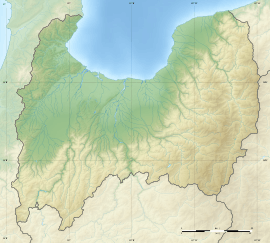Gokayama
| UNESCO World Heritage site | |
|---|---|
 Gasshō-zukuri houses in Gokayama | |
| Location | Nanto, Toyama, Japan |
| Criteria | Cultural: (iv)(v) |
| Reference | 734 |
| Inscription | 1995 (19th Session) |
| Coordinates | 36°25′32″N 136°56′8.6″E / 36.42556°N 136.935722°ECoordinates: 36°25′32″N 136°56′8.6″E / 36.42556°N 136.935722°E |
 Gokayama  Gokayama (Japan) | |
Gokayama (Japanese: 五箇山) is an area within the city of Nanto in Toyama Prefecture, Japan. It has been inscribed on the UNESCO World Heritage List due to its traditional gasshō-zukuri houses, alongside nearby Shirakawa-gō in Gifu Prefecture.[1] The survival of this traditional architectural style is attributed to the region's secluded location in the upper reaches of the Shōgawa river. This is also the reason that Gokayama's lifestyle and culture remained very traditional for many years after the majority of the country had modernized. Many of the houses surpass 300 years in age.[2]
The Gokayama region includes the former villages of Taira, Kamitaira, and Toga.[3] The gasshō hamlet of Ainokura is located in Taira, while that of Suganuma is in Kamitaira;[3] both are nationally designated Historic Sites.[4][5]
Ainokura
Ainokura, in the Gokayama region, was inscribed on the World Heritage List in December 1995 as one of the three villages of gassho-style houses.[6]
Ainokura has 20 gassho-style houses known as minka.[7] Most of them are 100 to 200 years old, and the oldest is said to have been built some 400 years ago.[2] The gassho roof has a slope of about 60 degrees forming a nearly equilateral triangle. This steep pitch allows snow to slide off the roof easily. The enormous roof is supported by stout oak beams called chonabari, which are curved at the base. The roofs are rethatched every 15 to 20 years. Nowadays this is done by Gokayama Forest Owners' Cooperative.[2][8]
Fumihito, Prince Akishino stayed at an Ainokura inn two times. The first time was when he was a second-year student at the Gakushūin high-school when he took part in a summer geography training seminar. While staying in Ainkoura, he said, "I like three places in the world most, one of them is Gokayama". The second time was nine years after that with his wife.
International relations
Twin towns – Sister cities
Gokayama is twinned with:

See also
References
- ↑ "Historic Villages of Shirakawa-go and Gokayama". UNESCO. Retrieved 25 June 2012.
- 1 2 3 Radzuan, Indera Syahrul Mat; Fukami, Naoko; Yahaya, Ahmad (September 4, 2014). "Incentives for the conservation of traditional settlements: residents' perception in Ainokura and Kawagoe, Japan". Journal of Tourism and Cultural Change. Routledge Informa Ltd: 301–329. doi:10.1080/14766825.2014.952302. Retrieved 16 July 2017.
- 1 2 "Tateyama-Kurobe Alpine Route and Gokayama" (PDF). Japan National Tourism Organization. Retrieved 25 June 2012.
- ↑ 越中五箇山相倉集落 [Etchū Gokayama Ainokura Hamlet] (in Japanese). Agency for Cultural Affairs. Retrieved 25 June 2012.
- ↑ 越中五箇山菅沼集落 [Etchū Gokayama Suganuma Hamlet] (in Japanese). Agency for Cultural Affairs. Retrieved 25 June 2012.
- ↑ "Historic Villages of Shirakawa-go and Gokayama". UNESCO. Retrieved 16 July 2017.
- ↑ "Ainokura Village". japan-guide.com. Retrieved 16 July 2017.
- ↑ "EXTERIORS - Gassho-style (thatch roof) houses in Shirakawa-Go, Japan". Retrieved 16 July 2017.
External links
| Wikimedia Commons has media related to Gokayama. |